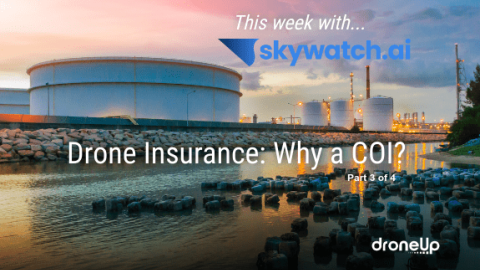So you’ve gotten the right safety training and you’ve started to consider your insurance options. Now what?
One of the most important aspects of your insurance plan is your Certificate of Insurance (COI). The COI serves as your proof of insurance coverage. On it, you will find all the important details about the plan you created, including your name, liability limit, active dates or hours, and any additional insured. When flying through SkyWatch.AI, you will receive your COI immediately after purchasing your insurance plan. You can add additional insured to your COI and policy at any time.
Whether you are flying for recreational purposes at a park, or being hired to fly for commercial purposes, you are almost always going to be asked to prove your insurance. Clients or event venues require you have it in order to get hired for a job. If you are not flying through the DroneUp app (where you will automatically be covered with an on-demand SkyWatch.AI policy), but rather through an individual mission, and you fail to present a COI, you will risk the chance of actually getting that job.
Before drone insurance became a requirement for many, we saw drone accidents with unfortunate endings simply because drone pilots did not incorporate insurance into their mission plan. For example, in a California wedding in 2016, a drone pilot was not asked to provide his insurance before he was hired for a wedding. The night took a turn for the worse when the pilot experienced a costly accident. Today, in 2019, this liability situation can be easily avoided due to the advancement of drone insurance. Pilots who specialize in wedding photography are expected to have liability insurance, and a way to prove it with a COI. Weddings are a great example of the time to purchase an on-demand policy as mentioned in our article: Where to Begin. Drone pilots can activate their drone insurance for weddings just for the hours they need it.
Additionally, insurance is also critical in other businesses where pilots focus on inspections. Using drones for inspection has proved advantageous when observing roof damage, power and gas lines, and construction sites, because they replace humans in unsafe working environments. However, while humans are spared from these conditions, drones can still create major issues and cause significant damage. In these situations, liability and hull insurance are both needed because there are damage risks to the drone itself.
Once you have purchased insurance and received your COI, your policy is set. While there is no regulation enforcing pilots to log their flights, for insurance purposes it is extremely beneficial. By logging your flights, you can produce flight-time documentation and records of drone use. Insurance companies specifically ask for this information and not having it easily accessible may lengthen filing your claim. Visit tomorrow, when will go into detail about how to strategically plan your insurance and what to do when you actually need to file a claim: “Dynamic Drone Insurance Planning.”
